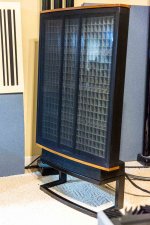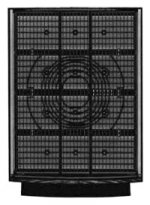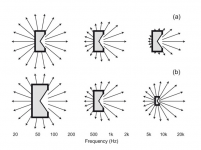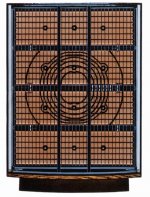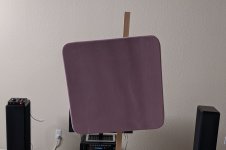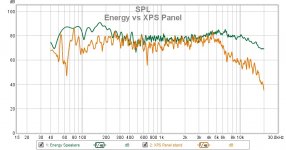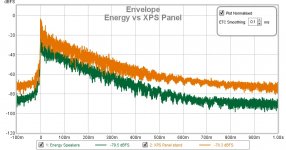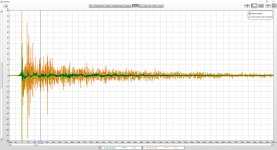Tectonic call this side the primary drive side and yes to an extent they do sound better ,the down side to this is the exciter itself ,a great chunk of vibrating metal and spider which causes massive disruption of the response in the 10k region and a phasey sound.
My spline is a wooden Home Depot hand rail.
https://www.homedepot.com/p/Alexand...Pine-Handrail-Moulding-0W231-20096C/205916987
I use steel wire to hold the actuators on the spline.
https://www.homedepot.com/p/OOK-250-ft-18-lb-24-Gauge-Galvanized-Steel-Wire-50137/100144004
I also have wires and chip amplifiers that may have resonances too. Material and design/build choices will impact resonances analogous to a standard enclosure.
OffGrid's material and build choices + tuning may make the actuator side sound better.
I agree that the loudspeaker world took a serious wrong turn when Kellogg and Rice's theory began dominating.
Does that mean cone drivers?
Floyd Toole's book explains why we have cone drivers. They're efficient air pressure wave couplers. I feel sorry for all the speaker designers who struggled throughout history. Contemporary DIY speaker builders still suffer from legacy loudspeaker trauma. The effort put into designing wave guides to control sound fields is impressive. Then you have Herculean efforts to design satisfactory enclosures leading to cabinets that weigh hundreds of pounds. A quick glance through the forums reveals DIY enthusiasts suffering audio PTSD (Phase Tone Soundfield Distortion.) Despite relatively inexpensive DSP and dirt cheap ruler-flat line quality amplification they choose to self-harm designing complex inflexible passive crossover networks powered by class-A amps.
I have not read Floyd Toole's book but I have read Vance Dickinson, Collums et al.
I think the development that has gone into cone based systems is very impressive, but IMHO its a bit like the development effort that went into Porsche 911's. It has taken many years of truly superb engineering to make them handle as well as they do ( I have tracked a GT3 ) but it remains true that for dynamics the engine is in a very dumb place.
I think the development that has gone into cone based systems is very impressive, but IMHO its a bit like the development effort that went into Porsche 911's. It has taken many years of truly superb engineering to make them handle as well as they do ( I have tracked a GT3 ) but it remains true that for dynamics the engine is in a very dumb place.
Yes. Probably a good analogy. Electric vehicles can drive each wheel with a separate motor and manage torque independently with software. But, unlike cars, audio is at the technological stage where it can be done at low cost.
100W class-D amps are only $2.50/ea. In DIY, there's no reason not to power each driver individually now. Commercial speaker manufacturers still have to worry about customer equipment, but DIYers get to customize.
100W class-D amps are only $2.50/ea. In DIY, there's no reason not to power each driver individually now. Commercial speaker manufacturers still have to worry about customer equipment, but DIYers get to customize.
Yes you are right, the tech we have today is extraordinary and will no doubt get better. DML’s can benefit from this as we understand them more. I would love to have an active panel surface so you can dial up as many nodes as you like. Or an exciter within a feedback loop to self correct for dominant resonance. Way outside my ability of course but I can dream.
Burnt
Burnt
Burntcoil.
I was very impressed with his explaining of figs 8 and 9 .
Way ahead of his time,it's still being argued about now,nearly 40years later.
I think the nxt patent was largely based on the computer software that predicted panel response ,but could be wrong .
Steve
I was very impressed with his explaining of figs 8 and 9 .
Way ahead of his time,it's still being argued about now,nearly 40years later.
I think the nxt patent was largely based on the computer software that predicted panel response ,but could be wrong .
Steve
Old school engineering, a bit like one of my favourite designers Kelly Johnson. The SR71 was designed with slide rules and physical intuition.
I really like the use of strips to fabricate the panel. A strip is a beam and so it’s performance , e.g natural frequency and modes, are much easier to calculate. Also the strips will be more compliant than if each surface was continuos. Of course the strips of the second layer being at right angles to the first makes it more complex but still manageable I would guess.
Clever man.
Burnt
I really like the use of strips to fabricate the panel. A strip is a beam and so it’s performance , e.g natural frequency and modes, are much easier to calculate. Also the strips will be more compliant than if each surface was continuos. Of course the strips of the second layer being at right angles to the first makes it more complex but still manageable I would guess.
Clever man.
Burnt
This might be relevant to your discussion on that patent. From Floyd Toole's book, Sound Reproduction: The Acoustics and Psychoacoustics of Loudspeakers and Rooms:
Regarding loudspeaker directivity, diaphragm size, and frequency wavelength.
"What about large-panel loudspeakers? Because directivity is determined by the wavelength relative to the size of the radiating surface, a large surface radiating the full audio bandwidth must become progressively more directional with increasing frequency. The limited displacement of electrostatic and electromagnetic panels requires that they be large in order to produce enough sound to be interesting. The usual solution for the directivity problem is to subdivide the panel into progressively smaller areas, radiating successively higher frequencies. Many employed a simple narrow tweeter strip. Perhaps the most ambitious example of this approach was the Quad ESL63, which drove the diaphragm with an arrangement of concentric rings, expanding the source area as frequency decreased, with the aim of generating the wavefront of a point source. Others curve the surface, but the nature of the drive mechanism allows only a gentle curvature.
There are practical reasons why cones and domes became and remain the prevalent loudspeaker paradigm."
Regarding loudspeaker directivity, diaphragm size, and frequency wavelength.
"What about large-panel loudspeakers? Because directivity is determined by the wavelength relative to the size of the radiating surface, a large surface radiating the full audio bandwidth must become progressively more directional with increasing frequency. The limited displacement of electrostatic and electromagnetic panels requires that they be large in order to produce enough sound to be interesting. The usual solution for the directivity problem is to subdivide the panel into progressively smaller areas, radiating successively higher frequencies. Many employed a simple narrow tweeter strip. Perhaps the most ambitious example of this approach was the Quad ESL63, which drove the diaphragm with an arrangement of concentric rings, expanding the source area as frequency decreased, with the aim of generating the wavefront of a point source. Others curve the surface, but the nature of the drive mechanism allows only a gentle curvature.
There are practical reasons why cones and domes became and remain the prevalent loudspeaker paradigm."
Attachments
I am very familiar with the directivity of panels having built several ESL’s over the years. The beaming effect is very evident with a tight sweet spot unless you try to mitigate it. DML’s don’t have this problem.
I understand why cones and domes followed the development path they did, I just believe it was the wrong path to take in the first place. There is also the issue of being able to analyse and model performance. Conventional cones and dome appear to be simpler. Just my two pence worth.
I understand why cones and domes followed the development path they did, I just believe it was the wrong path to take in the first place. There is also the issue of being able to analyse and model performance. Conventional cones and dome appear to be simpler. Just my two pence worth.
US3236958A - Loudspeaker system
- Google Patents
From the patent:
"Since, however, the wave-length is maintained constant, then the circumference of the unbafiled piston will have to be approximately five times as large as the bafiied one to produce the same power output at the given frequency. Thus, by simply choosing the right size radiator, there can theoretically be reproduced, by means of an unbafiled piston, any desired low frequency power equivalent to that of a considerably smaller boxed piston."
That looks like it might be a useful rule of thumb for DML design.
- Google Patents
From the patent:
"Since, however, the wave-length is maintained constant, then the circumference of the unbafiled piston will have to be approximately five times as large as the bafiied one to produce the same power output at the given frequency. Thus, by simply choosing the right size radiator, there can theoretically be reproduced, by means of an unbafiled piston, any desired low frequency power equivalent to that of a considerably smaller boxed piston."
That looks like it might be a useful rule of thumb for DML design.
US3236958A - Loudspeaker system
- Google Patents
Regarding low frequencies:
That's true except that later research described the influence of small rooms on low frequencies and their resulting modal behavior. In 1961 the patent writer would not have had access to that research. If your room is modal at those frequencies the stereo aspect (identifying where the low frequencies originated) doesn't do you any good anyway.
For that reason I'd lean toward cone speakers in the lower frequency ranges. However, the methods of correcting room modes might make me lean back toward DML panels because they have a shallower depth. In other words, I wouldn't choose DML for the reasons the patent author asserted but I might for a different reason that the patent author didn't know back in 1961. Or, a combo of cone and DML in the low frequencies. For example, a traditional cone enclosure in a room corner to "see all the modes" -- as Dr Earl Geddes suggests -- and DML panels to locate low frequency sources in different parts of the room where a cone enclosure might be inconvenient.
- Google Patents
Regarding low frequencies:
"Conventional speaker systems which use enclosure devices have a radiation pattern which is essentially a hemisphere at low frequencies causing widespread and random distribution of low frequencies throughout the listening area with contingent ambiguity of the direction from which the low frequency sounds originate. Consequently the directivity of low frequency sound emanations from boxed enclosures is obscured and is largely ineffective as far as stereo reproduction is concerned."
That's true except that later research described the influence of small rooms on low frequencies and their resulting modal behavior. In 1961 the patent writer would not have had access to that research. If your room is modal at those frequencies the stereo aspect (identifying where the low frequencies originated) doesn't do you any good anyway.
For that reason I'd lean toward cone speakers in the lower frequency ranges. However, the methods of correcting room modes might make me lean back toward DML panels because they have a shallower depth. In other words, I wouldn't choose DML for the reasons the patent author asserted but I might for a different reason that the patent author didn't know back in 1961. Or, a combo of cone and DML in the low frequencies. For example, a traditional cone enclosure in a room corner to "see all the modes" -- as Dr Earl Geddes suggests -- and DML panels to locate low frequency sources in different parts of the room where a cone enclosure might be inconvenient.
Here's something else from Floyd Toole's book
Figures 4.20a & b are attached in a single image.
I want to call out this portion of the quote.
DML high frequency reflections (ray acoustics above Schroeder room transition frequency) are not as concentrated as cone speaker reflections. So the problem Toole mentions should not be as noticeable.
With DMLs we might have beaming but it may not be as noticeable because it isn't enhanced by the ray acoustics. Or we might not have beaming because the high frequencies get absorbed by the panel before they get a chance to beam. Which might also be an argument in favor of high internal panel damping rather than deploying damping at the edges of the panel.
However, at higher frequencies—shorter wavelengths—the radiated sound will tend to become more focused in the forward direction of the diaphragm, radiating in a progressively narrowing beam. This is illustrated in a grossly simplified manner in Figure 4.20a; when the wavelengths approach and eventually become smaller than the diaphragm of the loudspeaker, it becomes more directional. This is a problem for two reasons
1. The off-axis, room reflected sound cannot have the same spectral balance as the direct sound. This is a problem for sound quality and sound localization.
2. Large diaphragms don’t behave well when driven at high frequencies. They acquire breakup modes—resonances—that color the sound.
However, if the size of the loudspeaker diaphragm is reduced as frequency increases, something closer to constant directivity can be achieved, along with much improved frequency and time-domain performance. This is illustrated in Figure 4.20b. The residual problem is that at very low frequencies the bass is radiated omnidirectionally, so the directivity control becomes effective in the low hundreds of Hz. In practice this is not an issue, because below the transition frequency what we hear is dominated by room modes, as will be discussed in Chapter 9. The choice of crossover frequency is based on both frequency response and directivity.
Figures 4.20a & b are attached in a single image.
I want to call out this portion of the quote.
1. The off-axis, room reflected sound cannot have the same spectral balance as the direct sound. This is a problem for sound quality and sound localization.
DML high frequency reflections (ray acoustics above Schroeder room transition frequency) are not as concentrated as cone speaker reflections. So the problem Toole mentions should not be as noticeable.
With DMLs we might have beaming but it may not be as noticeable because it isn't enhanced by the ray acoustics. Or we might not have beaming because the high frequencies get absorbed by the panel before they get a chance to beam. Which might also be an argument in favor of high internal panel damping rather than deploying damping at the edges of the panel.
Attachments
I don't know if the Quad ESL 63 might help with DML panel design, but maybe a concentric circle internal damping structure could be a good strategy. OffGrid Guy said he used hot glue in concentric circles to tune his DMLs and liked the results.
The ESL 63s used their concentric circle technique to address frequency wavelength beaming. Except in their case it was activation rather than damping.
The goal would be to reduce beaming but maybe DMLs don't beam anyway. I don't know why cone speakers and electrostats beam. Maybe DMLs are different in a way that fundamentally prevents beaming.
The ESL 63s used their concentric circle technique to address frequency wavelength beaming. Except in their case it was activation rather than damping.
The goal would be to reduce beaming but maybe DMLs don't beam anyway. I don't know why cone speakers and electrostats beam. Maybe DMLs are different in a way that fundamentally prevents beaming.
Attachments
Hi All,
I will admit that I haven't read the last 3 pages fully yet, but just wanted to ad that I love the sound of my DMLs "in some rooms and hate them in others". Cone speakers don't seem, to me anyway, to behave quite as badly as this when moved from room to room. We are all listening to, and measuring different DML 'layouts' in different rooms, and as such I am not surprised that there is so much conjecture between us. Keep experimenting though.
Simon
Just to ad. I am sure each room probably has its perfect position for my DML's, it's just that I haven't, for various reasons (WAF mainly) endeavoured to find it.
I will admit that I haven't read the last 3 pages fully yet, but just wanted to ad that I love the sound of my DMLs "in some rooms and hate them in others". Cone speakers don't seem, to me anyway, to behave quite as badly as this when moved from room to room. We are all listening to, and measuring different DML 'layouts' in different rooms, and as such I am not surprised that there is so much conjecture between us. Keep experimenting though.
Simon
Just to ad. I am sure each room probably has its perfect position for my DML's, it's just that I haven't, for various reasons (WAF mainly) endeavoured to find it.
Last edited:
Hi All,
.. but just wanted to ad that I love the sound of my DMLs "in some rooms and hate them in others".
Simon
True, I know mine sound far better in the room that has the subwoofer, haha.
Eric
Many years ago when I had my 6x2 ft x25mm eps panels in my front room , was moving them all around the room trying to find a good all round sound but I kept getting that same old suck out in the 100 to 300 hz region ,I was getting nowhere so decided to make a cup of tea to cool off,I left some live jazz music playing and went onto the kitchen ,would you believe it,it sounded fantastic, it sounded like the band was actually in the front room , but as soon as I entered the front room again the sound all collapsed again ,I just kept walking in and out of the room in disbelief.
The cancellations in the room were ruining the sound but for some reason in the kitchen there were no cancellations at all ,this is the main reason I use a cone (piston) diver in conjunction with the panel (dml )to cover this area together ,they both cancell out the dips to give a flat frequency response in the room the speakers and you are in.
Over on audiocircle I did have pics showing the response, but I don't think anyone took much notice,I should have been concentrating on full range only.
Steve
The cancellations in the room were ruining the sound but for some reason in the kitchen there were no cancellations at all ,this is the main reason I use a cone (piston) diver in conjunction with the panel (dml )to cover this area together ,they both cancell out the dips to give a flat frequency response in the room the speakers and you are in.
Over on audiocircle I did have pics showing the response, but I don't think anyone took much notice,I should have been concentrating on full range only.
Steve
Which was silly really as I was running my 6x2ft eps panels down to 50hz before rolling off.
And only then to stop the panel walking off when playing loud music with strong LF.
And only then to stop the panel walking off when playing loud music with strong LF.
this is the main reason I use a cone (piston) diver in conjunction with the panel (dml )to cover this area together ,they both cancell out the dips to give a flat frequency response in the room the speakers and you are in.
Audiocircle should have paid attention.
Spedge, I've heard the same here. Sadly though I now have a kitchen that is part of a living dining area so miss that effect. Although, my wife, who was sitting downstairs, did comment the other day how good and realistic the music sounded coming from the DMLs playing upstairs.
These days with even cheap electronics delivering near 'audiophile' performance (ie Chipamps and D Class) and the quality of the various music sources being so good, I believe that the biggest gains in performance are now achieved by tuning the listening room with either diffusers/bass traps or DSP.
These days with even cheap electronics delivering near 'audiophile' performance (ie Chipamps and D Class) and the quality of the various music sources being so good, I believe that the biggest gains in performance are now achieved by tuning the listening room with either diffusers/bass traps or DSP.
Recently built a DML panel and took some measurements and here are the results. For comparison I measured a traditional speaker in the same room and approximately similar spot. So we have something to compare against.
Setup details:
Comparing SPL graph between Energy speakers and XPS panel we see the XPS panels holds its own from 250Hz to 5KHz. Outside that region the response tapers off.
Looking at time domain graphs (ETC graph), we see that XPS panel has much more ringing. The impulse response graph also shows XPS panel not settling down as quickly as Energy Speakers.
Do any of you who have built a frame looked or posted ETC or Impulse response graphs? Would be good to see if frame helps in damping and improving the time domain characteristics.
Thanks
Setup details:
- Dayton Audio UMM-6 USB microphone.
- Traditional speaker used for comparison: Energy Audissey A2.2
- Foamular 2’x2’ project panel, rounded and smoothed edges (layer of glue+water not applied). Exciter mounted on stand. No spline or support for the panel.
Comparing SPL graph between Energy speakers and XPS panel we see the XPS panels holds its own from 250Hz to 5KHz. Outside that region the response tapers off.
Looking at time domain graphs (ETC graph), we see that XPS panel has much more ringing. The impulse response graph also shows XPS panel not settling down as quickly as Energy Speakers.
Do any of you who have built a frame looked or posted ETC or Impulse response graphs? Would be good to see if frame helps in damping and improving the time domain characteristics.
Thanks
Attachments
- Home
- Loudspeakers
- Full Range
- A Study of DMLs as a Full Range Speaker

